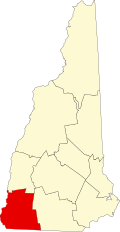T. H. Cabot Cottage | |
 Possibly the cottage (if greatly enlarged), or a replacement building | |
| Location | Snow Hill Rd., Dublin, New Hampshire |
|---|---|
| Coordinates | 42°53′53″N72°4′7″W / 42.89806°N 72.06861°W |
| Area | 0.7 acres (0.28 ha) |
| Built | 1899 |
| Architect | Cabot, Elise Pumpelly |
| Architectural style | Georgian Revival |
| MPS | Dublin MRA |
| NRHP reference No. | 83004016 [1] |
| Added to NRHP | December 15, 1983 |
The T. H. Cabot Cottage is a historic summer house off Snow Hill Road in Dublin, New Hampshire. The cottage is one several buildings that was built by geologist Raphael Pumpelly on his summer estate "Pompilia". Built in 1899 after his daughter's marriage to Thomas Handasyd Cabot, it is a good example of Georgian Revival architecture. The house was listed on the National Register of Historic Places in 1983. [1]


